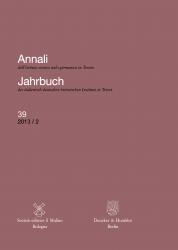Annali dell'Istituto storico italo-germanico in Trento | Jahrbuch des italienisch-deutschen historischen Instituts in Trient, 39, 2013/2

Editore: il Mulino - Duncker&Humblot
Città: Bologna - Berlin
Anno: 2013
Pagine: 126
Cartaceo
Indice
Vorwort | pp. 7
- Edoardo Tortarolo, Das Italienisch-Deutsche Historische Institut. Frühneuzeitforschung zwischen Deutschland und Italien
pp. 9-28
Aufsätze
- Pierre-Antoine Fabre, Zur Bilderverehrung in der letzten Periode des Konzils von Trient. Untersuchungen und Hypothesen
pp. 31-54 - Giulia Guazzaloca, Das Fernsehen, die RAI und die Parteien. Der Primat der Politik in der Geschichte von Rundfunk und Fernsehen in Italien
pp. 55-81
Besprechungen
- S. Bauer, Giuseppe Antonio Guazzelli - Raimondo Michetti - Francesco Scorza Barcellona (Hrsg.), Cesare Baronio tra santità e scrittura storica
pp. 85-87 - M. Rospocher, Giovanni Ricci, Appello al Turco. I confini infranti del Rinascimento
pp. 87-90 - A. Vanni, Susanna Peyronel Rambaldi, Una gentildonna irrequieta. Giulia Gonzaga fra reti familiari e relazioni eterodosse
pp. 90-93 - C. Ferlan, Ottavia Niccoli, Vedere con gli occhi del cuore. Alle origini del potere delle immagini
pp. 93-95 - K. Occhi, Guido Alfani - Matteo Di Tullio - Luca Mocarelli (Hrsg.), Storia economica e ambiente italiano (ca. 1400-1850)
pp. 96-99 - V. Sebastiani, Tiziana Plebani, Un secolo di sentimenti. Amori e conflitti generazionali nella Venezia del Settecento
pp. 99-101 - A. Dessardo, Fulvio De Giorgi, Mons. Montini. Chiesa cattolica e scontri di civiltà nella prima metà del Novecento
pp. 101-104 - P. Pombeni, Enrico Galavotti, Il Professorino. Giuseppe Dossetti tra crisi del fascismo e costruzione della democrazia 1940-1948
pp. 105-109 - G. Bernardini, David W. Ellwood, Una sfida per la modernità. Europa e America nel lungo Novecento
pp. 109-113 - G. D’Ottavio, Antonio Varsori, L’Italia e la fine della guerra fredda. La politica estera dei governi Andreotti (1989-1992)
pp. 113-116
Nachrichten aus dem Institut
- Tagungs - und Vortragsaktivitäten | pp. 119
- Publikationen | pp. 124
- Bibliothek | pp. 126
- Autoren | pp. 127
Abstract
Edoardo Tortarolo - Das Italienisch-Deutsche Historische Institut. Frühneuzeitforschung zwischen Deutschland und Italien
nessun abstract
Pierre-Antoine Fabre - Zur Bilderverehrung in der letzten Periode des Konzils von Trient. Untersuchungen und Hypothesen
In continuation of an analysis of the Council of Trent’s decree on the invocation of saints, the veneration of relics, and the sacred use of images (P.-A. Fabre, Décréter l’image?, Paris 2013, Italian translation in preparation) and after recalling how the decree constitutes a compromise in Trent between a reformist party and a party primarily concerned with maintaining tradition, a new perspective is introduced here. This is an exception to the silence of the sources on the development of this Council: two letters by Guglielmo Sirleto, librarian of the Vatican Library, addressed to Giovanni Morone, the papal legate at Trent in 1563, in which the Roman scholar calls the Tridentine prelate’s attention to the Byzantine heritage in the worship of images before the backdrop of a longing for the unity of the churches of Rome and Byzantium, which sounds slightly odd at a time when the old medieval christianitas seems to us dominated by the trauma of the Reformation
Giulia Guazzaloca - Das Fernsehen, die RAI und die Parteien. Der Primat der Politik in der Geschichte von Rundfunk und Fernsehen in Italien
This paper investigates the relationship between the broadcasting system and the overall political system, which developed in Italy in 1950s and 60s, i.e. the institutions, the parties, and the various political cultures present in the society’s social fabric. Indeed, the roots of the currently much-discussed Italian «television issue» lie far in the past, when the Democrazia Cristiana was in power and the broadcasting service was a RAI monopoly. It was then that—amidst polemics, conflicts, and attempts at reform—the «supremacy of politics» consolidated itself, which was to characterize all of the history of Italian television. The Democrazia Cristiana, which recognized the new mass medium’s potential for creating political consensus and forging a new «national culture» long before the other parties, developed an efficient pedagogic strategy, which certainly bore abundant fruit. Only to get stuck in its strategy when—by the early 1970s—both the political equilibrium and the demands as well as the Italian spectators’ level of «maturity» had changed.

